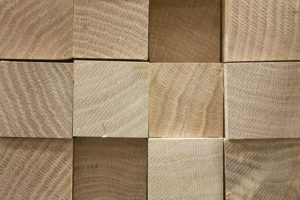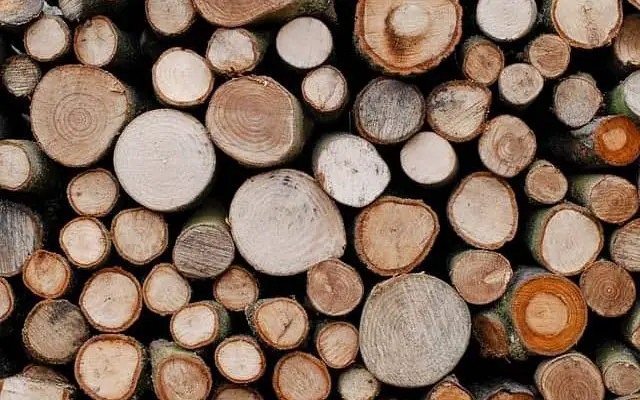The classification of woods by splitting them into two categories, Hardwood or Softwood, has little to no bearing on defining the wood density or workability. The terms are given to a species of tree based on the seeds it produces, not the relative density of the wood contained within. Hardwoods are any variety of angiosperm, more commonly known as a deciduous tree. These broad-leaved trees typically shed their leaves once per year during colder months. Angiosperm is a greek word which means “encased seed.” Trees in this category have their seeds protected either by a fruit, nut, or other seed covering. Softwoods are gymnosperms, which means “naked seed.” Their seeds are left unprotected when they fall to the ground. These trees are commonly referred to as evergreens or conifers.
Generally speaking, softwoods (pine, fir, etc) grow much faster than hardwood species and typically this results in a relatively softer wood. With few exceptions, you can generally assume that woods from a softwood tree will be less dense than woods from a hardwood tree. One exception which is often given as example is balsa. Balsa is the softest, least dense wood variety in the world, but surprisingly, it is classified as a hardwood tree due to the balsa seed being encased in a protective pod.
 Putting aside technicalities, when it comes to woodworking, most hardwoods you will find available at local retailers will be significantly more dense than common softwood lumber which is typically pine and fir. There is an objective test available to determine the relative hardness of a wood species known as the Janka test. This test is performed by measuring the force needed to embed a small steel ball halfway into a sample of wood. The janka test is most commonly referred to when selecting wood species for flooring, but depending on your project needs, you may wish to research the hardness of those species that are readily available to you.
Putting aside technicalities, when it comes to woodworking, most hardwoods you will find available at local retailers will be significantly more dense than common softwood lumber which is typically pine and fir. There is an objective test available to determine the relative hardness of a wood species known as the Janka test. This test is performed by measuring the force needed to embed a small steel ball halfway into a sample of wood. The janka test is most commonly referred to when selecting wood species for flooring, but depending on your project needs, you may wish to research the hardness of those species that are readily available to you.
You can find many charts and graphs online detailing the relative hardness of different species of wood, but for our purposes we will keep it simple. Let’s define softwood as any pine or fir species (including cedar) and everything else as hardwood. The most common hardwood species available in North America retailers are: oak, maple, walnut, cherry, and poplar. Hardwood suppliers will often have many more species available, and for the most part, they all behave similarly when using tools and fasteners on them.
Five Major Factors
There are many factors involved in choosing the correct type of wood for your project. This list details only the characteristics of the wood itself, and doesn’t factor in your specific project type. We’ll cover that in the next sections.
Cost – If cost is a major concern, you will find that softwoods are significantly more cost efficient. This, among a few other factors are why most construction lumbers are made from softwoods.
Durability – Hardwoods, being naturally more dense, will stand up to wear and tear more than softwoods. Most fine furniture will be made of harder wood species that can withstand everyday use. Wood flooring is typically made of hardwood species for this same reason.
Stability – Wood expands and contracts over time with changes in humidity. Hardwoods are less affected by seasonal changes and will retain their shape better with changes in moisture content. This is why we use hardwood for cabinets, doors, and drawers that are fitted with tight tolerances.
Fastening – Hardwoods are rarely used in construction applications because more care is needed in fastening the wood. Nails are a poor choice for hardwood because the tight grain is more likely to split with the force of driving a nail. Screws are needed to fasten hardwoods and often you will need to pre-drill holes to further prevent cracking and splitting. On a construction site, time is money and power nail guns are used to fasten softwood quickly and securely.
Appearance – Hardwood grain is much tighter and branches are much less frequent along the length of the tree. Many consider these qualities to be superior in appearance to pine and other softwoods. Most softwoods will have wide grain patterns and prominent knots along the length of the planks.
Choosing Wood for Your Project
Every discipline of woodworking has various requirements that dictate the need for softwood or hardwood. Using construction as an example, where speed and costs are the main factors, softwoods are the only choice that make sense. Framing a house with expensive black walnut would not serve to make the house stronger, and the beauty of the wood would be hidden inside the walls.
I cannot detail every type of woodworking here and detail the pros and cons of softwood vs hardwood for each. I would very likely leave out disciplines I have not considered prior. Instead, I’ll try to walk through the pros and cons of using softwoods and hardwoods in a more generalized fashion. Hopefully, you will be able to determine what is best for your project.
Softwood
Like the name implies, softwood is rather soft. The grain is very large due to the rapid growth of the parent trees and this makes the wood likely to splinter and split along the grain lines. Because softwood trees grow so quickly, they are considered a sustainable crop. This factor alone is the reason that construction grade lumber is universally softwood. Managed forests can be clear-cut and replanted in quick order and turned over in a decade or less, allowing for a steady stream of softwood lumber.
Softwoods, specifically pine and fur, have been used for thousands of years in general construction projects for a variety of purposes. It would be wrong to assume that you cannot use softwood in projects that are intended to last generations, or applications that will receive wear and tear. Early american homes and flooring were most-often built with pine and many examples of these floors exist today in excellent condition. Douglas fir, has been used for hundreds of years in boat building and is still in use today.
 Softwoods are an excellent choice for most craft and hobby projects. The wood is readily available at larger stores and is easily workable with hand tools and home shop tools. The appearance of knotholes and large grain is also desirable for the modern “rustic” look. Using distressing techniques on softwood can quickly give them an aged appearance. This works especially well after painting to give your project an older, well-worn look.
Softwoods are an excellent choice for most craft and hobby projects. The wood is readily available at larger stores and is easily workable with hand tools and home shop tools. The appearance of knotholes and large grain is also desirable for the modern “rustic” look. Using distressing techniques on softwood can quickly give them an aged appearance. This works especially well after painting to give your project an older, well-worn look.
Often, it’s not about the wood species that you choose, but rather how the project is cared for over time. Early American furniture is often softwood pine, fir, and cedar and the traditional look of this furniture has grown in popularity in recent years. With proper finish and care, these pieces can last for generations with minimal damage and repair needed. Denting is the most common issue you will face when using softwood for your projects. In flooring, area rugs and runners can be used in high-traffic areas to help reduce surface damage from dropping hard objects. Similarly, tablecloths, place mats and doilies can be used.
The softness and wide grain of softwoods make them easy to join with most types of fasteners. Generally, nails and wood screws can be used without splitting the wood and pre-drilling is unnecessary. Care must be taken, however, when driving a fastener near the end of a plank to avoid splitting the end. If your project is going to have exposed fasteners near the ends of boards, I would recommend that you pre-drill first.
This softness is sometimes attractive to new woodworkers because the perception is that it will be easy to work with. This can be somewhat of a trap however. While pine can be easily cut, it is not a good choice for carving, turning, marquetry, or fine joinery. The wood is prone to tearing along the grain and can be very unforgiving. It can be difficult to achieve fine details because it is so easy to over-shoot your marking or carving lines. Sanding with power tools is also a challenge. While it’s certainly possible to achieve exceptional results with softwood, newcomers are often discouraged by the results they see from these woods.
Finishing techniques for softwoods are similar to hardwood techniques. Sanding to grits above 240 are unlikely to show markedly better results in un-treated softwoods. The grain is just too large in these woods. After applying finish or stabilizing the wood with oils, epoxy, ect. you can sand with much higher grits with excellent results. Softwoods respond well to paints, stains, and varnish but care must be taken for some applications:
Staining
Stain can be tricky with pine and fir. The grain on these woods can vary in density many times over the length of a plank and this can produce a splotchy, or uneven appearance. Manufacturers often recommend a pre-stain conditioner when using their products on softwoods. A liberal coat of conditioner is typically applied about 20 minutes before you stain your project. The conditioner will soak into the open fibers and act as a barrier for the more porous areas of the softwood. This helps the stain sit more evenly on the surface.
Painting
Paint bonds very well to softwoods because of the porosity of the wood. Either water-based or oil-based paints work well on softwood and absorb readily into the open fibers of the wood which also helps to preserve the wood against aging and rot. Knot holes are a concern when working with pine and fir as they will bleed through your painted surface shortly after painting. If possible, seal the knots beforehand with an oil based or shellac primer that is designed to prevent bleeding.
Varnishing
Finishing bare softwood can be a challenge to perfect. You must be extra cautious with sanding to prevent sanding marks in the wood and apply your finish in very thin layers, sanding between coats. The first few layers of your finish will likely soak into the wood, but that’s okay. This helps to strengthen the top wood fibers which makes the surface easier to sand smooth.
Hardwood
There are so many varieties of hardwood it would be impossible for me to give you a hard set of rules to follow that apply to all species. The janka test I described earlier would be a better place to start to understand the properties of the specific wood species you need. If, for instance, you wanted a wood for a particular appearance, select the woods that look the best to you and then consult the janka test to determine how best to work with those woods.
The harder a wood is, the more difficult it will be to cut and fasten. You will need to be more  considerate about pre-drilling fasteners and taking your time with power tools. With rare exception, hardwoods have very poor nail-holding properties. It is almost always advisable to use screws with pre-drilled holes or traditional joinery techniques when using hardwood. However, the benefits of harder woods may outweigh the difficulty of working with them. Remember, the harder the wood, the more stable it is. This means your project is much more likely to retain its shape and less likely to split apart as the wood expands and contracts with humidity changes.
considerate about pre-drilling fasteners and taking your time with power tools. With rare exception, hardwoods have very poor nail-holding properties. It is almost always advisable to use screws with pre-drilled holes or traditional joinery techniques when using hardwood. However, the benefits of harder woods may outweigh the difficulty of working with them. Remember, the harder the wood, the more stable it is. This means your project is much more likely to retain its shape and less likely to split apart as the wood expands and contracts with humidity changes.
For certain types of projects, hardwood is the only appropriate choice. Cutting boards are an example of a project that many new woodworkers enjoy and they should never be made out of softwood. The pores of softwood are too open and can trap food and harmful bacteria in the wood, making them dangerous to use. There are some hardwoods that are not suitable also, so you must be careful when making projects that will come in contact with food.
Hardwoods can be classified as either open or closed grained. This is determined by the vascular structure of the wood. Closed grain hardwoods have tyloses which block off the vessels of the wood at regular intervals. The tylose is an outgrowth on these vessels that the the tree will use to “dam” up the vessels which protects the wood from drought and infection. Open grain woods do not have these obstructions and their vessels form long straws which run the entire length of your plank. These woods can draw moisture through the entire plank due to capillary action. This makes these woods unsuitable for use in cutting boards and other high-moisture areas such as boat building.
Finishing
One of the most rewarding aspects of working with hardwoods is the large variety of color and grain patterns available. Often, stains applied to softwood are an attempt to approximate the variety of hardwood colors. Often, craftsmen will choose to do nothing more than sand and apply a clear varnish. Some hardwoods may even be sanded and polished without need for varnishes.
Staining
Hardwoods take stain very well and rarely require the use of a pre-stain conditioner. Maple and birch are exceptions. Alternatively, gel stains work well with all varieties of hardwoods because they are not readily absorbed.
Painting
When painting hardwood, you should not sand the surface beyond 220 grit. If you sand your project too smooth, you may experience trouble with the paint not sticking properly. Paint hardwood with oil-based paints without primer. The extended drying time of the oil allows it to soak into the wood and form a harder bond for the paint.
Varnishing
Both oil and water based finishes can be used on hardwoods with similar results. You should thin the first few coats of finish considerably. This will allow the varnish to penetrate into the wood which will result in a more resilient finish. Hardening oils such as teak, linseed, and walnut oil are excellent choices for most hardwoods. These oils protect the wood but also allows the natural feel and beauty of the wood to remain.
Choosing the wood that’s best for your project is one of the joys of woodworking. There are no hard and fast rules that can be applied to every type of wood and every type of project. Hopefully I’ve given you enough of an insight to get you started. Like most skills, learning which woods are best suited to which project is just a matter of practice and patience. Research your project and the types of wood most generally used and then make your choice. Happy woodworking!




